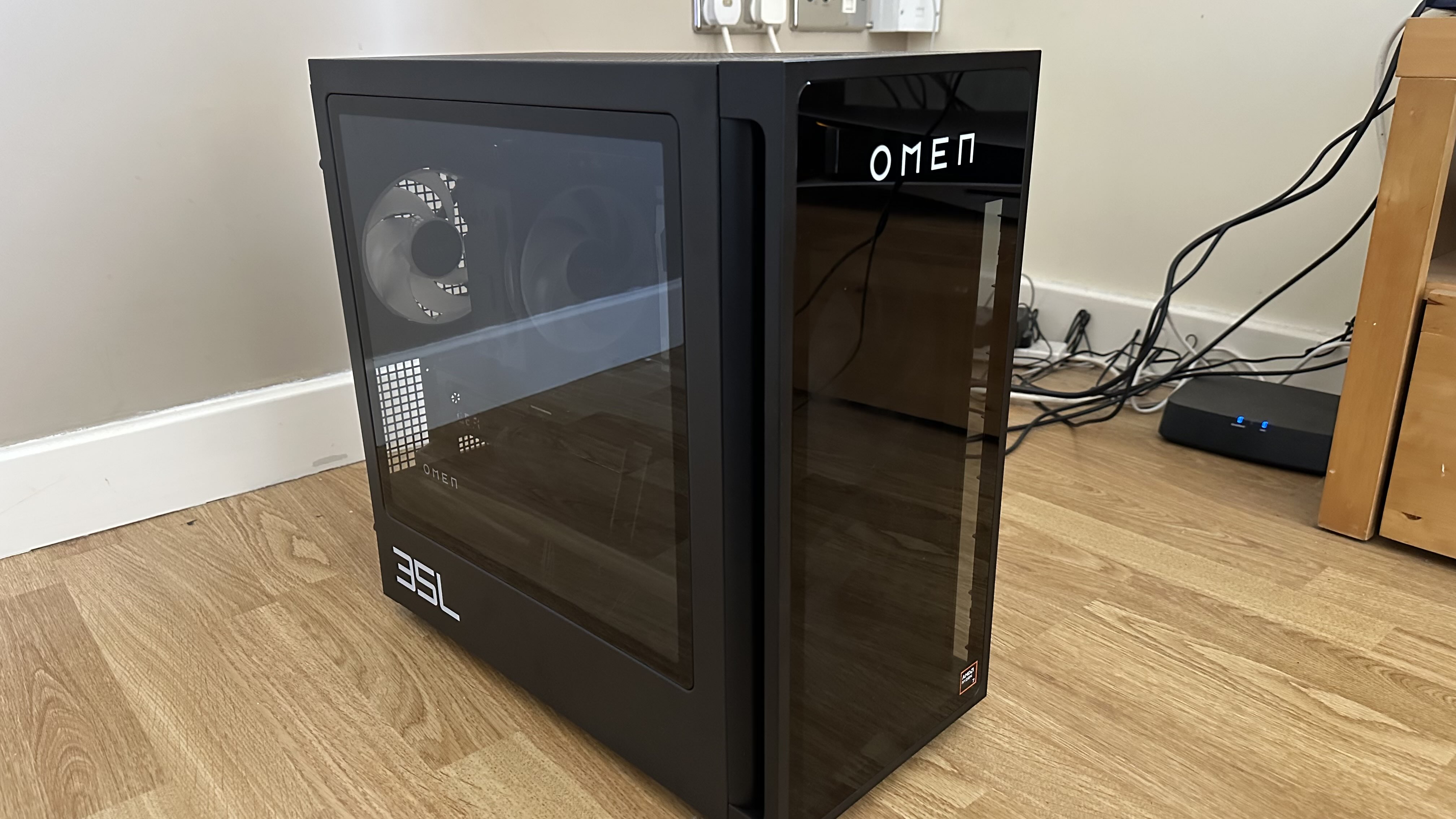GamesRadar+ Verdict
The HP Omen 35L delivers some stellar performance at 4K, 1440p, and 1080p, ensuring that no matter what resolution you choose to play at, you’ll always be getting a premium experience. But with a high price tag, it is up to you if that experience is worth the money.
Pros
- +
Great performance across 4K, 1440p, and 1080p resolutions
- +
Easy to upgrade
- +
Simple to setup and use
- +
Quality mid-to-high range PC
- +
Lots of availability
Cons
- -
The price is quite high
- -
Only one HDMI port
- -
WD Blue SSD isn’t the fastest
- -
No AIO cooler as standard
Why you can trust GamesRadar+
I didn’t consider myself a PC gamer until last year. I was always content with console gaming and the options those platforms offered me. However, in recent months, I have found myself more immersed in the PC space - thanks to my Steam Deck and my GeForce NOW subscription - and now I’m in the market for something that gives me the ‘beef’ that I’d expect from this powerful gaming platform.
Unlike consoles, though, there are often far too many options and variables when looking at a pre-built gaming PC, so it is hard to know what parts to trust before handing over your hard-earned cash. This is where the HP Omen range shines. Personally, I have been surrounded by HP products in my family home since I was but a small child, so I have 26 years of knowing this brand well, which makes a £1,799/$1,679.99 lump sum a little easier to stomach. But elsewhere in the market, HP Omen has built a reputation for its 25L, 40L, and now-discontinued 30L desktops. Unlike some of the best gaming PCs, though, these use premium, well-known components - there’s no question about where your money is going.
Housed inside the new, redesigned HP Omen 35L chassis is exactly that ‘beef’ I mentioned earlier, an NVIDIA GeForce RTX 4070 SUPER, which easily surpasses the performance of familiar consoles like the PS5 and Xbox Series X, while also avoiding the insane prices of the RTX 50 series. However, will it finally cause me to put down my Steam Deck and DualSense controller? It very well could.
Specs
PC specs are always fascinating to me. For the longest time, my mind would always jump to the all-important GPU, in this case, the NVIDIA GeForce RTX 4070 SUPER - a GPU we gave 4.5 stars when we reviewed it last year. But the rest of the muscles the 35L can flex shouldn’t be ignored.
Sporting an AMD Ryzen 7 8700G, which we’d argue is one of the best value processors on the shelves today, that central CPU/GPU combination is capable of a lot of heavy lifting. Combine that with 16GB of Kingston Fury DDR5 RAM and a WD SSD, and you’ve got a really strong configuration. Depending on how you organize your library, the 1TB capacity should be more than enough space for your games - or at least Call of Duty.
Having previously reviewed a Refract Gaming Jade PC last year which housed an NVIDIA RTX 4060 Ti, I was very excited to be able to level up my experience with a higher-tier GPU and compare the two cards within the games I played
Price | $1,679.99 / £1,799 |
CPU | AMD Ryzen 7 8700G (other options available) |
GPU | Nvidia GeForce RTX 4070 Super (other options available) |
RAM | Kingston Fury DDR5 RAM 16GB |
Storage | WD Blue SN560 1 TB PCIe Gen4 NVMeTM M.2 SSD |
PSU | 850 W 80 Plus Gold certified ATX power supply |
Design
I think I have this misconception around PC gaming now. For the longest time, I believed that it was inconvenient because you’d be confined to your desk to play games. Let’s be honest, who wants to come home from their 9–5 at a desk and then sit at another desk to relax? I know I don’t - I think that’s why I was so drawn to the Steam Deck. However, since being able to review the Refract Gaming Jade PC and now the HP Omen 35L, I know that modern gaming PCs can be small enough to fit right next to my TV.
The HP Omen 35L’s redesigned case is nice and compact and blends in well with my entertainment space, sitting proudly beside my PS5, Xbox Series S, and Nintendo Switch without looking out of place. While it isn’t as small as the Acer Predator Orion X, I did notice it to be smaller than the Refract Gaming Jade PC, which was nice. Besides its size, it feels like this new chassis was long overdue, and after complaints about the HP Omen 25L and 30L being a tad too noisy for some, the 35L can now include an AIO liquid cooler. As much as this seems like it comes as standard (since one appears in a lot of the marketing images), I don’t have one in my review sample.
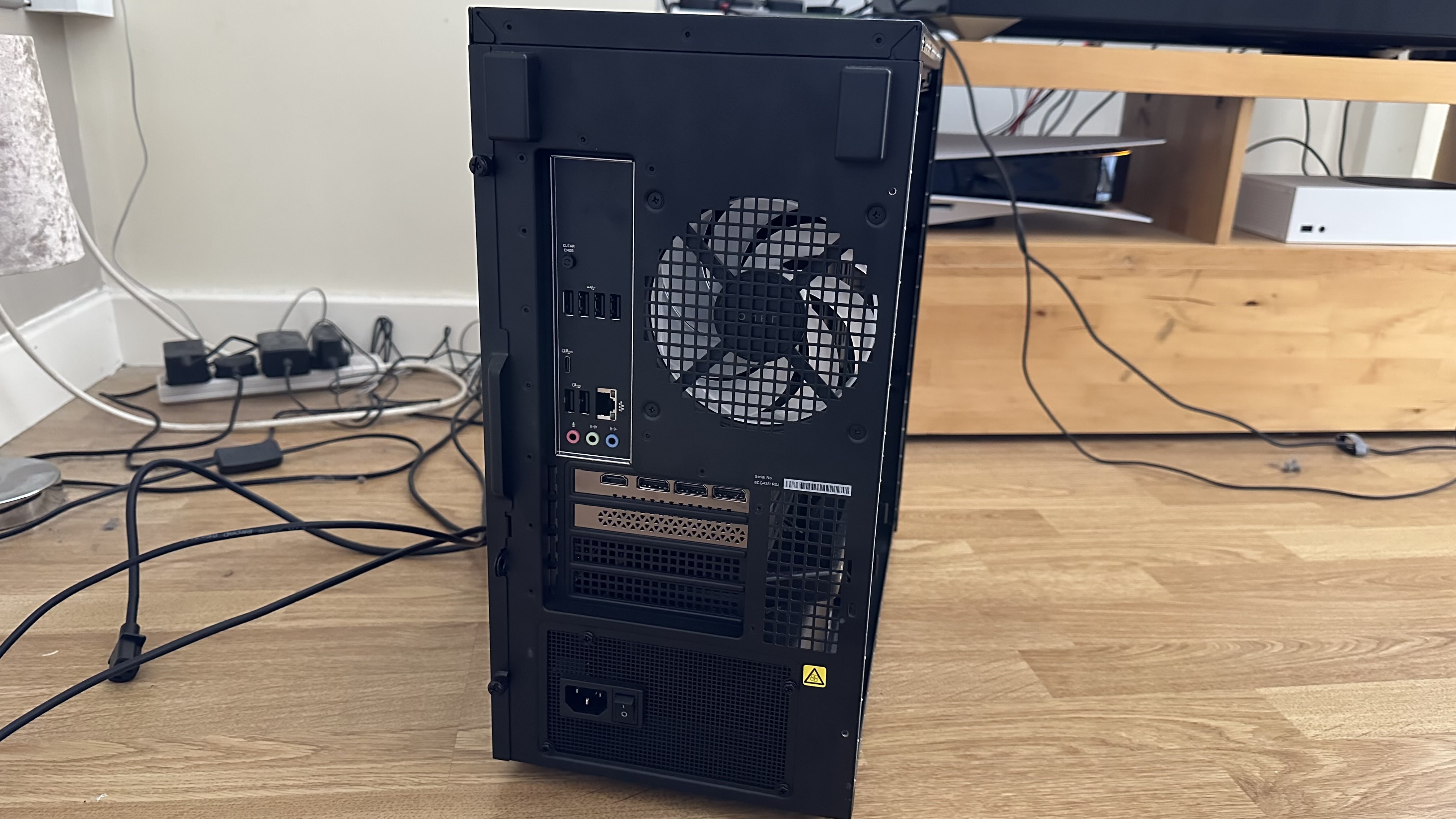
As mentioned, I’ve been testing the RTX 4070 Super version of this rig, straight from HP itself. However, like with previous Omen machines, there are loads of configuration options available, partly thanks to excellent availability from other retailers. From a quick browse at HP’s own retailer in the UK, I can see a few different RTX 4060 versions that offer those with limited budgets a chance to get in on the ground floor. However, there are other HP Omen 35Ls available at the likes of Very and Currys. In the US, the same is true of Walmart, Best Buy, and Amazon, which means you’re rarely going to find this out of stock, and you should always have a look for the best prices and specs before purchasing. Just be aware that some parts, depending on who you buy from, may vary, but HP does ensure that the WD Black SSD, the Kingston Fury RAM, the chassis, and everything but the GPU and CPU will always remain the same.
Along the front of the PC, you’ll find some RGB fans to lighten up your gaming space or your living room, alongside one USB-C port, two USB-A ports, and a headphone/microphone jack. Moving to the rear of the case, you’ll find another USB-C, six more USB-A ports, another microphone port, an audio-in port, and an audio-out port. You’ll also find an HDMI 2.1 port and three DisplayPort 2.1 slots in the GPU.
Aesthetically, I really like the design of the case, and the range of ports on offer is really helpful., However, I would have liked an additional USB-C port on the front of the PC, as more and more peripherals are demanding this port now. It isn’t the end of the world, but it would be nice to have for the future.
Performance
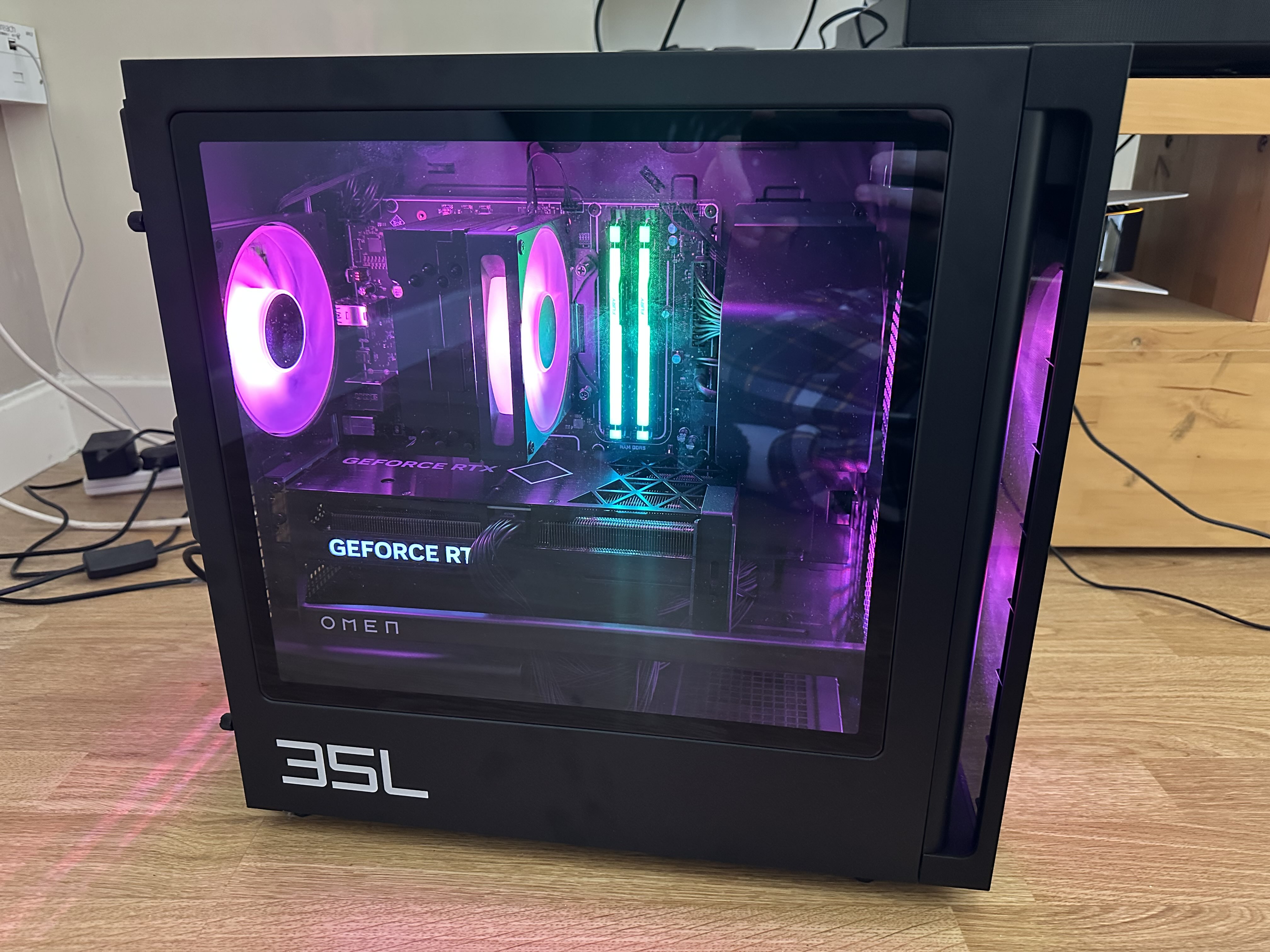
The HP Omen arrived at just the right time. I am a huge Assassin’s Creed fan, and with the recent launch of Assassin’s Creed: Shadows, I was looking for a way to experience the game at its fullest potential. While I could have opted for my PS5, I was disappointed to see such a stark difference between the base console and the PS5 Pro’s ports of the game. It made me realize that to get the best experience, I had to turn to PC gaming.
Comparing it to other gaming PCs, you may need to pay a bit more, but luckily, you can often find these rigs discounted, and they’re so widely available at other retailers that you have so many options to consider.
In stepped the HP Omen 35L. With an RTX 4070 Super, I was almost guaranteed to have a better time visually speaking, especially thanks to the onboard DLSS wizardry. Booting it up for the first time, I was amazed at just how much, and to use the word again, ‘beef’ this thing has. I was able to run the game at max settings at 4K on my 49-inch TV and still achieve the 60fps it’s capable of. Granted, I set DLSS to “quality” setting, but it was indistinguishable to my eye - another neat feature that you don’t have in most console gaming. While this isn’t quite as smooth as something like the NZXT Player Three PC, which features an NVIDIA GeForce RTX 5080 and runs Shadows at 100fps, you’re also not spending a couple of grand more, so I’ll take that as a win.
The only thing that I found strange during my 25 hours of playtime in Assassin’s Creed: Shadows was a very strange visual glitch when using the in-game map while DLSS is enabled. It almost appeared as if it was struggling to upscale the image from the rendered resolution. I tested this via GeForce NOW and tried to replicate that on the RTX 4080 cards they give you access to, but it never occurred. Regardless, with so many driver discrepancies and the game being so close to launch, PC gaming does open you up to these minor visual glitches. At least this isn’t the fault of a gaming PC that can’t run the game capably.
Despite being absolutely hooked on Assassin’s Creed: Shadows, I managed to pull myself away to utilize the RTX 4070 Super in some other games that I might not have been able to max out before.

One of those is Cyberpunk 2077. Putting aside the absolutely atrocious condition of the game at launch, this is one of the most stunning and visually impressive games you can experience. I’ve played through the game twice now, once on my PS5 using the native PS5 version of the game and again on my Steam Deck - which was surprisingly the more enjoyable of the two, it’s crazy how well that runs on Valve’s handheld - but I still never felt I was getting peak CyberPunk.
Booting it up, I ran to the settings menu and whacked everything to max. Ray tracing? Overdrive. Path tracing? On. 4K? Yup! Admittedly, I once again turned to our trusty friend DLSS and frame generation because I knew it was gonna be an intensive experience and every little helps, but I was raring to go. Jumping into the game and I was blown away by what I was seeing. It was like a completely different game compared to what I had thrown over 100 hours into across PS5 and Steam Deck. I’ll break down the performance benchmarks of this very soon, but for such a powerhouse of a game that’s been engineered to make the best graphics cards sweat, I was getting a very playable experience that sat around 50fps. I did venture back into the settings and moved DLSS to balanced, and that opened it up to get past that 4K60fps experience you’d hope for in this day and age, and the Omen 35L nailed it.. However, the best experience I had from this was sitting at my desk running everything max but in 1080p on my monitor - it looked absolutely stunning on a smaller panel with higher pixel density, and ran like a dream.
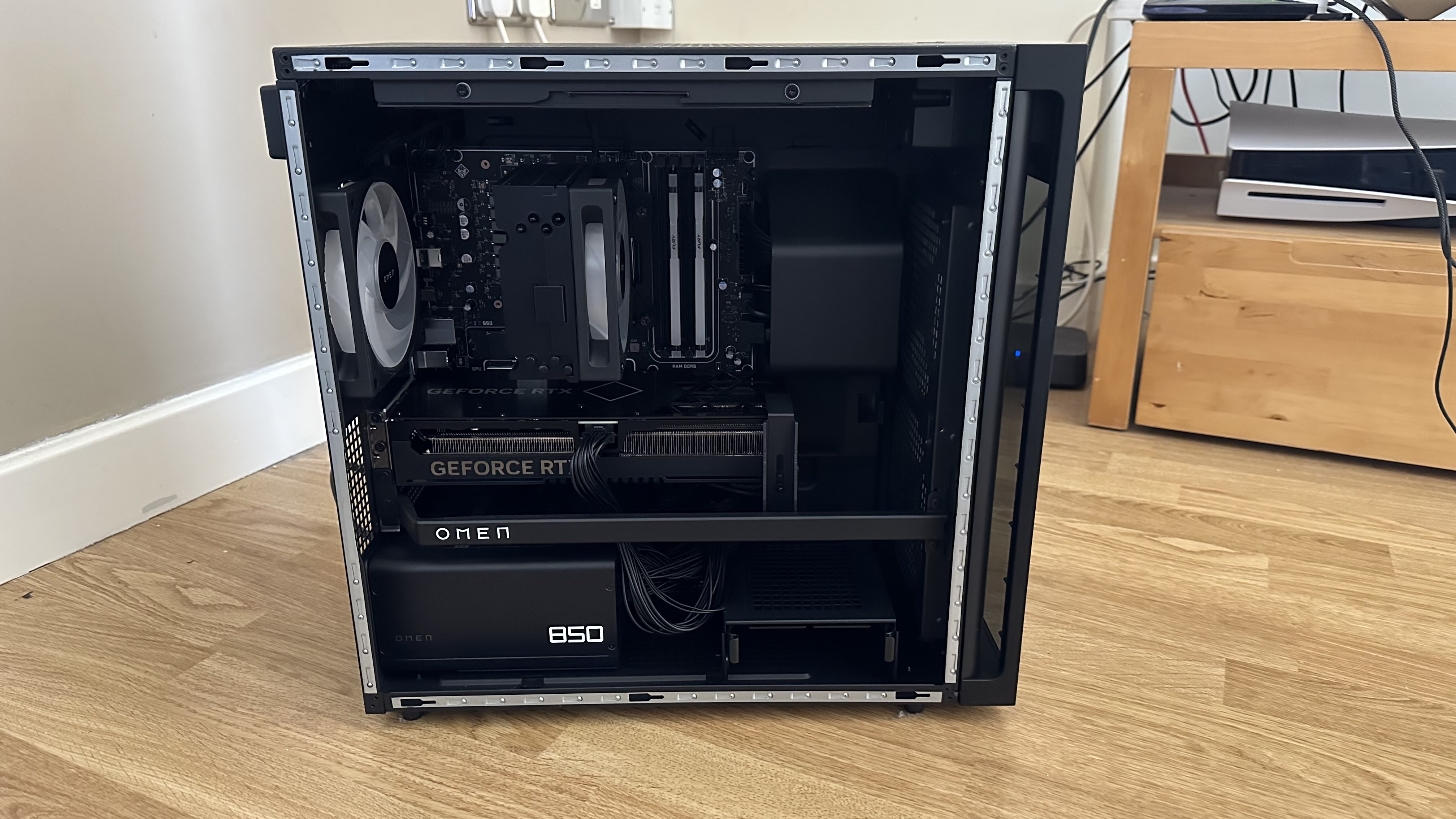
All of this is to say that, even if there are newer GPUs and CPUs out there that’ll score higher benchmarking scores than the Omen 35L, there’s great value for money to be had here. This is a versatile and very capable PC that’ll give you enough power and futureproofing to tackle modern games at any resolution that works for you, and that’s what mid-range PC performance should be striving for.
Next, I wanted to directly compare my experiences with what I had when I reviewed the Refract Gaming Jade PC, so I downloaded The Last of Us Part 1 because, of course, I have to have a side of PlayStation with my PC gaming main course. I am thankful to say that even at 4K and max settings, I never encountered any of the issues I faced with the Refract Gaming Jade, and instead, the HP Omen ran it smoother than my PS5 does in fidelity mode.
Overall, I didn’t run into many issues playing games, aside from that visual glitch in Assassin’s Creed: Shadows that I mentioned. Occasionally, I would see frame drops here and there, but that was mostly because I was really putting the PC through its paces at max settings. Generally, though, while this PC is capable of 4K, the best experience in terms of consistency across games came from running them at 1440p or 1080p.
As you can see by the benchmarking results, the HP Omen 35L performed well across all of our testing games, especially Shadow of the Tomb Raider, Hitman, and Returnal. I adore Hitman and don’t ever need an excuse to jump back into the World of Assassination - especially not when it looks this good. Miami is one of my favorite maps in the entire series, and it looks absolutely stunning while maxed out; all the visual delights without actually having to buy a flight to Florida.
I’m coming from the console perspective, so personally, as long as I am getting a 60fps experience, then I am a happy camper, and that is exactly what the HP Omen gave me. For the most part, thanks to the various configurations within the graphics settings of games, I am able to hit that target and have a better experience than I would on other platforms.
Another nice aspect is just how quiet the HP Omen remains even during high-stress testing. I never once noticed the hum of the fans while gaming, which is such a pleasure as I found the Refract Gaming Jade PC to be comparable to a jet engine and was expecting something similar here.
Cinebench:
Multi Core: 17134pts
Single Core: 1787pts
3DMark:
TimeSpy: 18,413 (Graphics score - 20,514, CPU Score - 11,652)
Firestrike: 36,387 (Graphics - 46,206, physics - 30,537, combined - 15,778
Steel Nomad: 4,639
CrystalDiskMark:
Sequential read: 5,018 MB/s
Sequential write: 3,441 MB/s
RAM readings:
5200 MT/s/ 46-46-46-92
I was also impressed by the SSD in the HP Omen as it sped through everything I threw at it with ease. I was quickly able to load into games, and waiting times were kept at a minimum thanks to a sequential read speed of 5,018 MB/s and a sequential write speed of 3,441 MB/s. This isn’t quite the speed of the best SSDs for gaming these days, but since a lot of gaming PC builders insist on using WD Blue drives, it’s about as good as you’ll get in any prebuilt machine. Similarly, transfer speeds were lightning-quick. Prior to the PC arriving, I had downloaded Assassin’s Creed: Shadows onto my external SSD to quickly move over the HP Omen. This took only a couple of minutes to transfer the full 109GB folder.
Looking at the rest of the benchmarking, I was impressed by the results across the board. Cinebench showed that the AMD Ryzen 7 8700G is a pretty solid CPU and won’t struggle under the pressures of both the multi-core and single-core tests. What this means day-to-day is that you’ll be absolutely fine gaming, streaming, and content creating.
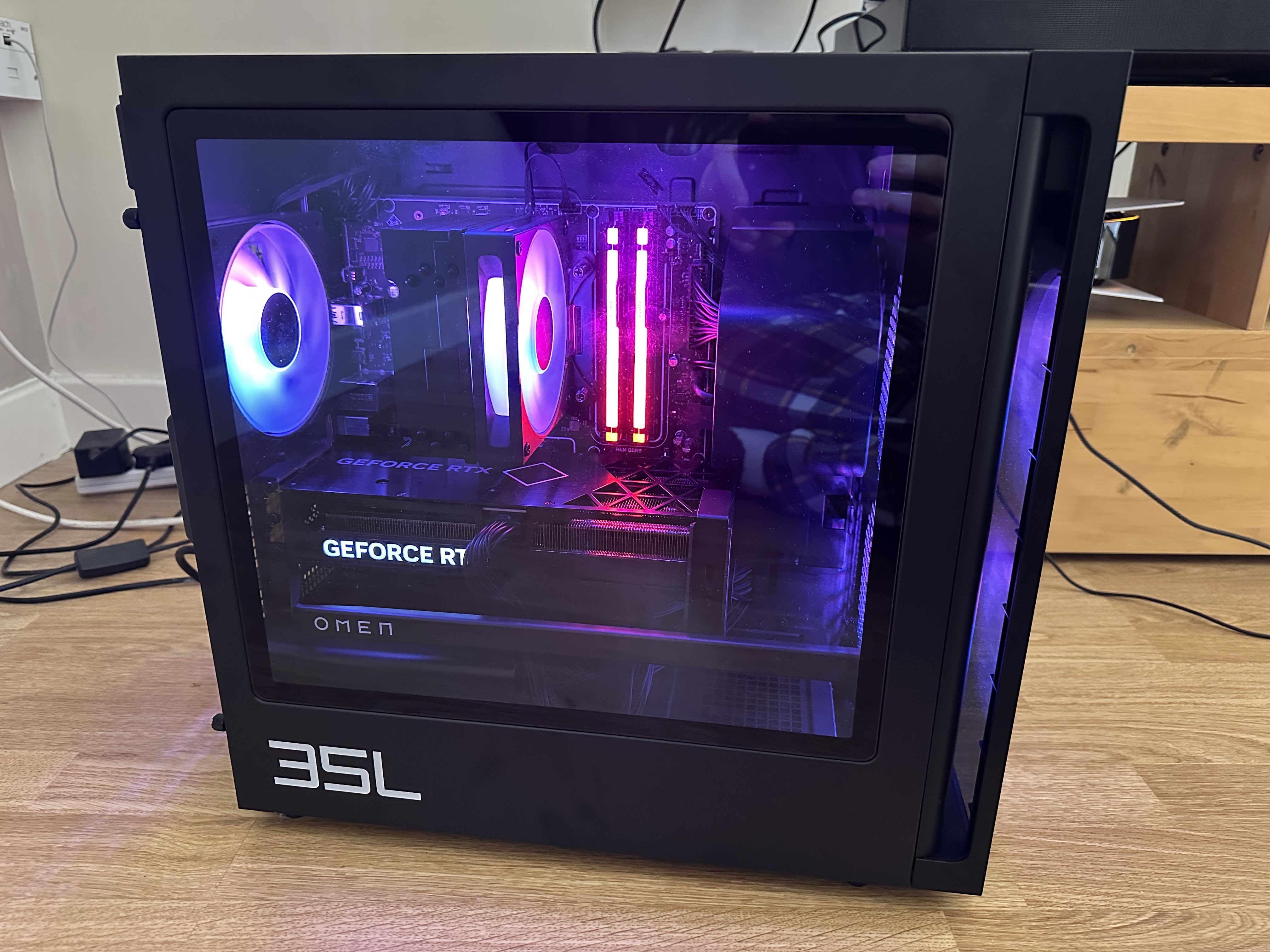
The 3DMark results I was similarly impressed with, especially when comparing them to the Refract Jade. In Time Spy, Firestrike, and Steel Nomad, the HP Omen consistently performed well and exceeded what I was expecting, which puts it comfortably in that upper tier of gaming PCs targeting 1440p and 4K gaming, evidenced by what I saw when playing Assassin’s Creed: Shadows and Cyberpunk 2077.
Generally, the PC didn’t get too warm during gaming, certainly not enough for me to notice, which is nice. Heading into summer, you don’t want a PC that is going to act as a space heater, although maybe come Christmas, this would be a more desirable feature. I think it is really helped by how well ventilated the HP Omen is. Not only are there two fans on the ceiling exhausting heat from the chassis, but the front of the case also sports two large RGB fans that keep temps to a minimum. We’d always recommend a configuration with an AIO cooler, especially since these can work out quieter, but the airflow system in this case was good enough that I didn’t miss liquid cooling too much.
Should you buy the HP Omen 35L
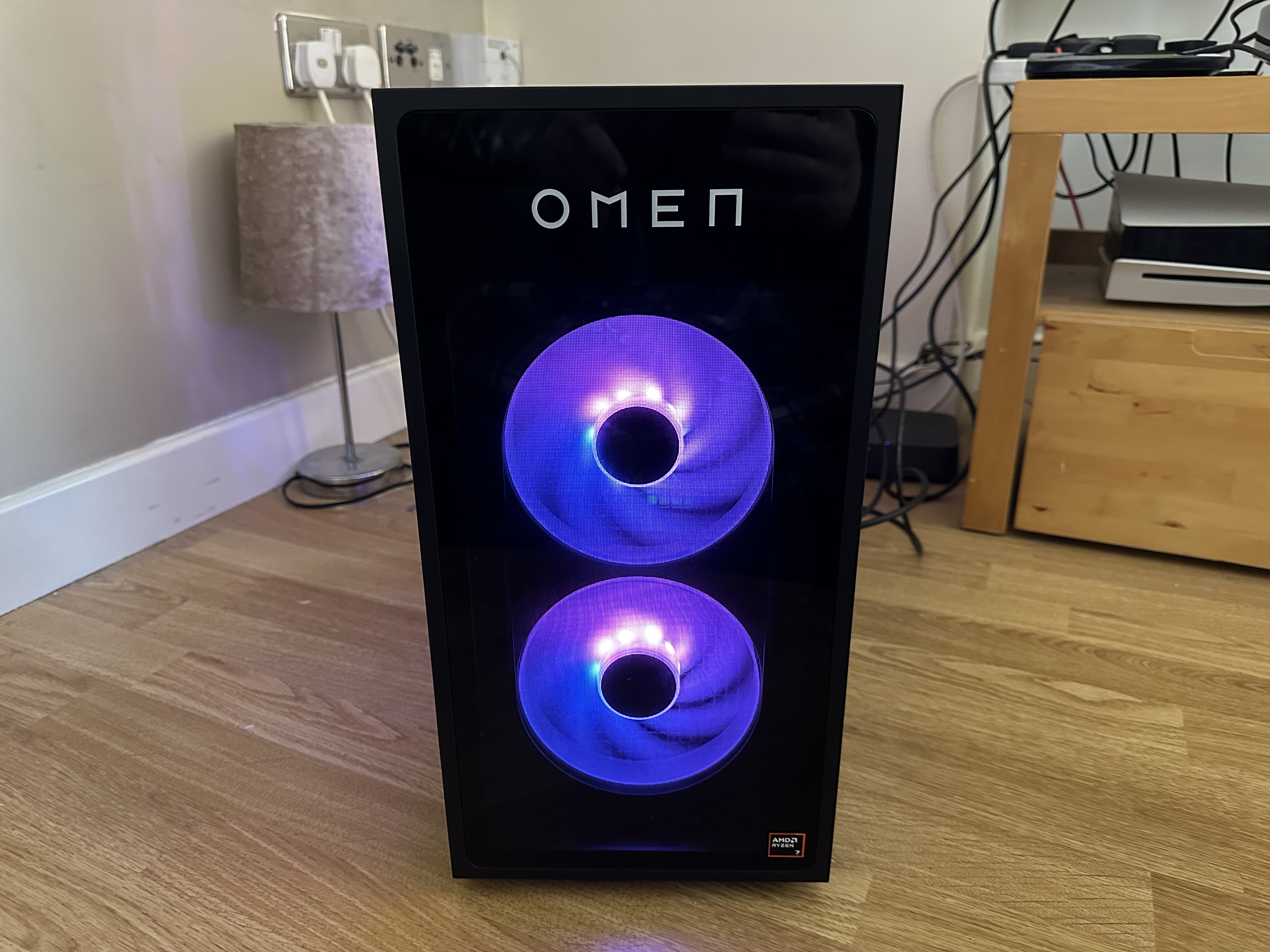
I always find this question the hardest aspect when it comes to reviewing anything. My initial thought when I’m asked this time is ‘yes, you should because it gives you great graphical fidelity that you’d expect from a modern gaming PC.’ However, there is a slight asterisk next to it because I’m not quite sure if I can personally justify the cost in the grand scheme of things.
So I’m going to look at this as a two-part question. If you want to play some of the most technically impressive games at their absolute max settings, then the HP Omen is something you should consider purchasing. The stats speak for themselves, you’re getting better performance than you would if you opted for a console, and often with higher graphical detail too. It’s got some powerful kit under the hood, and more premium kit than a lot of other prebuilt systems have. Often, other builders will opt for lesser parts to keep profit margins higher and prices lower, but HP is one of the few manufacturers that actually uses premium parts you’ll likely have heard of from even a little shopping around. And, depending on the configuration you’re considering, I’m willing to bet HP’s prebuilt comes cheaper than if you were to build it yourself.
However, here comes that asterisk. The configuration I’m testing is £1,799 / $1,679.99 which is a lot of money. This is a full £1000 more than even the PS5 Pro, which, to my eye, gives a similar enough experience for how I play. Granted, a PS5 Pro can’t do everything a PC does and doesn’t give the same level of customization or futureproofing, but it is also much cheaper by comparison if you aren’t trying to hit over 4K60. Comparing it to other gaming PCs, you may need to pay a bit more, but luckily, you can often find these rigs discounted, and they’re so widely available at other retailers that you have so many options to consider.
And that is what I think it essentially comes down to: if you need a machine that can do it all, not just gaming, but don’t want to compromise on graphical fidelity, then yes, you should buy the HP Omen 35L. But if you don’t want to spend this much money, then there are cheaper builds out there.
How we tested the HP Omen 35L
I used the HP Omen for three weeks as my home PC and main source of gaming. This, alongside gaming, involved video editing, Photoshop, and some light After Effects work. I tested it in two setups: first, alongside my 4K TV in my living room, and secondly, at my desk with my two 1080p computer monitors.
Benchmarking was conducted via the in-game option in our go-to games, Cinebench, CrystalDiskMark, CPU-Z, and 3DMark. As mentioned throughout the review, I played close to 30 hours in Assassin’s Creed: Shadows alongside The Last of Us Part 1, Cyberpunk 2077, and Hitman.
For more on how we test gaming PCs and their components, check out the full GamesRadar+ Hardware Policy.
Trying to build your own PC? Check out the best CPUs for gaming, the best RAM for gaming, and the best PC cases.
For as long as I can remember, I've had a fascination with video games and technology. From a young age, I was always reading up on the latest tech and begging my parents to buy it for me - now I have my own job and make my own money, I realize why they often had to say no to my requests. For that reason, I love trying to find the best value gear so I can recommend it when asked. I studied Journalism at Edinburgh Napier University and throughout my time there gaming was one of my main focuses. Alongside Duncan Robertson, I was the co-host of NerdCulture, a weekly gaming and nerdy news radio show. My time as Studio Manager for the uni radio station meant tinkering with a lot of technology to ensure each broadcast worked smoothly. Elsewhere, you can find me discussing professional wrestling as Cultaholic's Community and Social Media Manager, and you'll also see me on the occasional Twitch stream.
You must confirm your public display name before commenting
Please logout and then login again, you will then be prompted to enter your display name.
